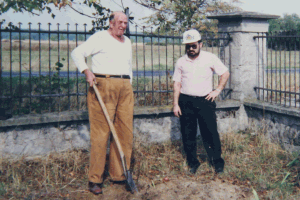Rest in Peace
| May 4, 2016
His death, like his life, was cold and lonely. There were no friends or family members to sit at his bedside during his final moments, to hold his hand and whisper some last parting words or say a few kapitlach of Tehillim for his soul’s journey. He was alone and abandoned in a cold hospital room as he took his last breath and returned his soul to its Creator.
They didn’t even know his name.
He was brought to Ichilov Hosptial in Tel Aviv without any identification, although a few people recognized him as the lonely man who used to sit at the end of Rechov Neve Shaanan, begging for alms. Paramedics brought him to the hospital after he collapsed one afternoon, but the pockets of his tattered garments didn’t contain a single identifying document or scrap of paper with a name or phone number. Still, he was a Jew who had to be given a Jewish burial, but who didn’t have an acquaintance in the world to provide it for him.
Ichilov contacted Reb Moshe Speigel, the funeral director at Petach Tikvah’s Beilinson Hospital and director of Chevrah Kadisha Shomrei Hadas, to collect the body and prepare it for burial. Speigel, as every hospital in the area knows, is the chesed shel emes address when it comes to burying the abandoned, the homeless, the anonymous. Although no one knew the man’s name in life, Speigel wanted to make sure he’d have some marker of his existence in This World even after death. But who was he? Speigel spoke to everyone on the hospital staff who’d cared for him, hoping to find a hint, and one nurse reported that the man had whispered a name to her before losing consciousness. Perhaps he was trying to identify himself?
Speigel and his team set out with this clue, scanning the phone books for someone with that name. They found several such names, one of them showing a residential address not far from where the niftar regularly begged for charity. Perhaps the apartment would give more clues to this man’s life.
The apartment, it turned out, was little more than a dark, airless hovel exuding a revolting odor and overflowing with garbage, dirty dishes, tattered, filthy rags draped over old, broken pieces of furniture, and infested with mice. At least they knew they were in the right place. Speigel and his team, undeterred by the stench or the filth, were grateful for that. They got down on their knees on the cracked floor tiles, rummaging through the piles of detritus in the hope that they’d find some sort of document that could shed light on the identity of the deceased.
Speigel finally located a single piece of paper: a certificate attesting to a promotion the man had once received in a health facility where he worked.
With the document in his pocket — a single, silent testament to the fact that its owner had once actually lead a normal life, working hard to move forward in the world before he found himself on the street — Speigel headed for the facility in the hopes of making a positive identification, and his efforts paid off. The staff identified the man as a male nurse who had once worked there, and provided Speigel with enough information so that he could now prepare a proper gravestone and contact family members who would sit shivah for him.
Everyone Knew Her
That story happened twenty years ago, but what about this year and the year before? In our post-modern era of saturated communication, where everyone seems to be connected to someone, are there Jews — especially in Eretz Yisrael — who still leave the world all alone?
“If you only knew how many unfortunate or lonely people ended their lives that way, and how many such cases I deal with even today,” he sighs.
Speigel, together with his friend and partner, Reb Chaim Moshe Polovinsky z”l, founded Shomrei Hadas, whose goal is to make sure that the hundreds of people who die alone every year are given a proper burial. Over the years he’s also dealt with bringing the remains of people who were buried in desolate parts of chutz la’aretz, in churchyards or in forests, to proper Jewish burials.
Today, Moshe Speigel is in his sixties, but he was a young bochur in army fatigues when he began doing this chesed shel emes during the 1973 Yom Kippur War as part of his service in the IDF rabbinate. “I was responsible for identifying the bodies of fallen soldiers,” he relates. That meant the gut-wrenching job of climbing aboard scorched tanks that had been brought back from the battlefield and patiently extracting the remains of the crew. Some of their bodies could be identified only by the dog tags hanging around their necks. For many weeks after the war ended, Speigel continued in his efforts to locate the families of the victims who were still unidentifiable.
Long before the Yom Kippur War though, Speigel grew up in a home where this ultimate chesed was one of its foundations. Born in postwar Munkatch, he was a child of parents who had survived the Holocaust, and a grandson and great-grandson of Jews who had been fiercely dedicated to preserving the honor of the deceased. His great-grandfather was the first family member to work for a chevrah kaddisha, and his grandmother ran what was essentially a chevrah kaddisha from her own home.
Oops! We could not locate your form.
